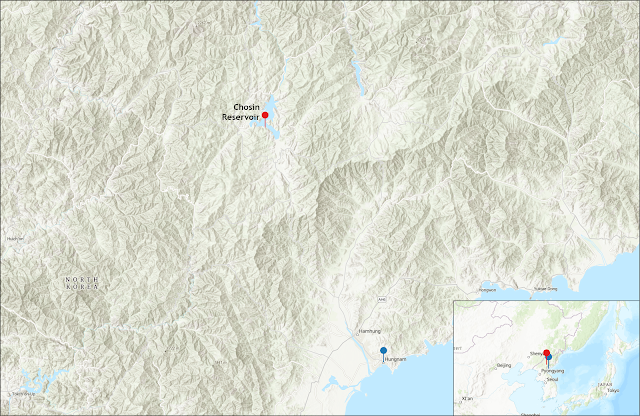The Battle of Chosin Reservoir (Korean War)
Date: November-December, 1950
Modern Location:
Changjin Reservoir, North Korea
Combatants:
United Nations (including United States, South Korea, and United Kingdom, led by Maj. Gen. Oliver P. Smith) vs. China and North Korea (led by Gen. Song Shilun)
Summary:
In the winter of 1950, China entered the Korean War on behalf of the North, and the landscape of the conflict shifted dramatically. After a successful invasion at Inchon in October that crippled the Korean People's Army, General Douglas MacArthur recognized that North Korea had lost the majority of their organized fighting forces and ordered the continued advance northward on all fronts. While MacArthur led the US 8th Army north from Inchon on the west side of North Korea, forces on the east side of the Korean Peninsula pushed through mountainous terrain in an effort to sever a key supply line, seeking to end the war quickly in a move called the Home-by-Christmas Offensive. A significant number of troops from the Chinese People's Volunteer Army (PVA), however, had crossed the border into North Korea and advanced undetected towards the Chosin Reservoir with orders from Mao Zedong to destroy the UN troops there. After engaging forces south of the reservoir in late November, PVA troops feigned a retreat in an effort to draw the fight northwards. Their strategy was to destroy UN positions to the east and west of the reservoir, then cut off the road south that represented the only possible path for retreat. A successful round of surprise attacks by the Chinese during the night of November 27 left a significant number of UN units isolated from one another. Combined with overwhelming resistance on the western front, MacArthur ordered a retreat from North Korea. For the units around Chosin Reservoir, that meant a difficult 78-mile journey south down a steep, rocky road to the port at Hungnam. After more than a week of fighting, the trapped UN forces had regrouped at Hagaru-ri on the southern edge of the reservoir and were finally able to begin their breakout retreat.

From December 6-11, the battle-weary troops fought their way south through the PVA forces that had completely encircled them at the reservoir, leading General Smith to comment that it wasn't a retreat as much as it was "advancing in a different direction". Before moving through many portions of the road it was first necessary to clear the high ground to either side, and then hold the position until the single-file column had passed. The Chinese attacked from every side while simultaneously setting up a defense at Funchilin Pass in front of the retreating convoy and blowing up a bridge to halt the escape. A group of US planes was able to drop portable bridge segments by parachute, however, and the breakout was able to continue. Defending Chinese divisions to the south had taken so many casualties by that point that they were unable to contain the retreat, and the remainder of the UN forces were able to reach the safety of Hungnam. With strong naval artillery support, an organized evacuation of all remaining troops, heavy artillery, and approximately 1/3 of the refugees in the city was performed by a total of 193 ships. On Christmas Eve, the last boats destroyed the port as they left, leaving very little behind for the Chinese army who marched into the city the next day.
View south from the reservoir toward Hungnam:
Geography:
The battle was fought over some of the most difficult terrain imaginable, along a road that had been cut into hillsides and between imposing peaks. Additionally, the weather was bitterly cold, as temperatures plunged more than 35 degrees below zero as a Siberian cold front swept across the Korean Peninsula. In addition to the life-threatening chill creating icy conditions, it also caused malfunctions to weapons and vehicles. Despite all of these factors working against the UN troops, it may have been more problematic for the Chinese units who had not been properly equipped with winter gear prior to entering North Korea. Estimates show that well over 25,000 of the PVA's 50,000+ casualties had non-battle causes, including many troops who were found by UN forces already frozen in their foxholes.
Result:
The Battle of Chosin Reservoir was an important engagement to both sides of the conflict. It was a geographic victory for the Chinese supporting North Korea, and it essentially ended UN hopes for a victory that would result in reunification. The successful retreat and evacuation of forces supporting South Korea, however, prevented the PVA from achieving their purpose of eliminating all enemies in North Korea. The ability of the US X Corps, including the 1st Marine Division, to remain intact as a viable fighting unit contrasts against the numerically superior PVA 9th Army which had to disband numerous divisions due to heavy losses. The Truman administration and United Nations Command abandoned their goal of victory in favor of returning to the original purpose of preserving the Republic of Korea in the south, and the comparatively successful outcome from Chosin Reservoir gave them the strength they needed to retain their foothold. The fighting continued another year and a half until an armistice was signed on July 27, 1953 and although the war technically never ended, both North and South Korea have now existed independently for nearly 70 years.




Comments
Post a Comment